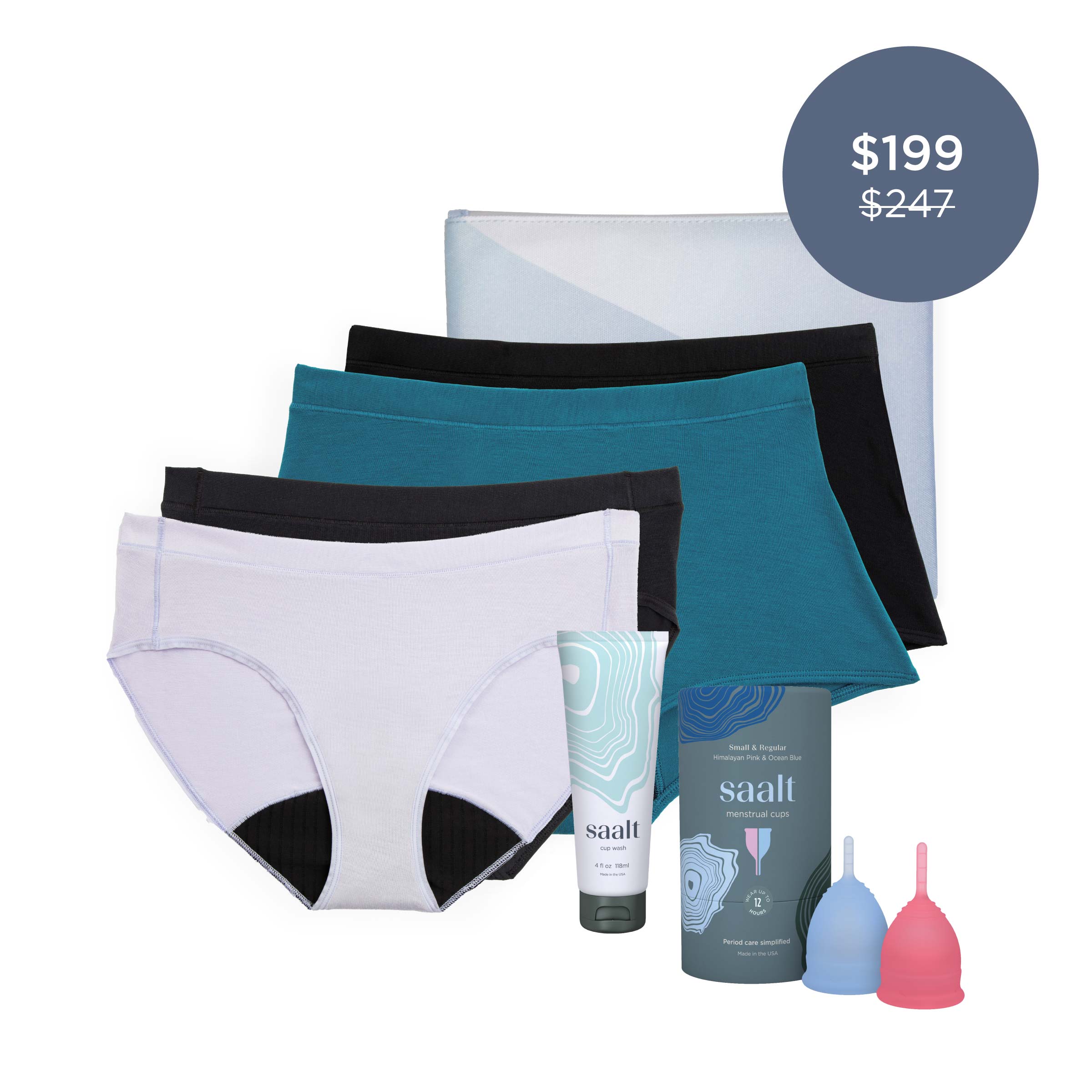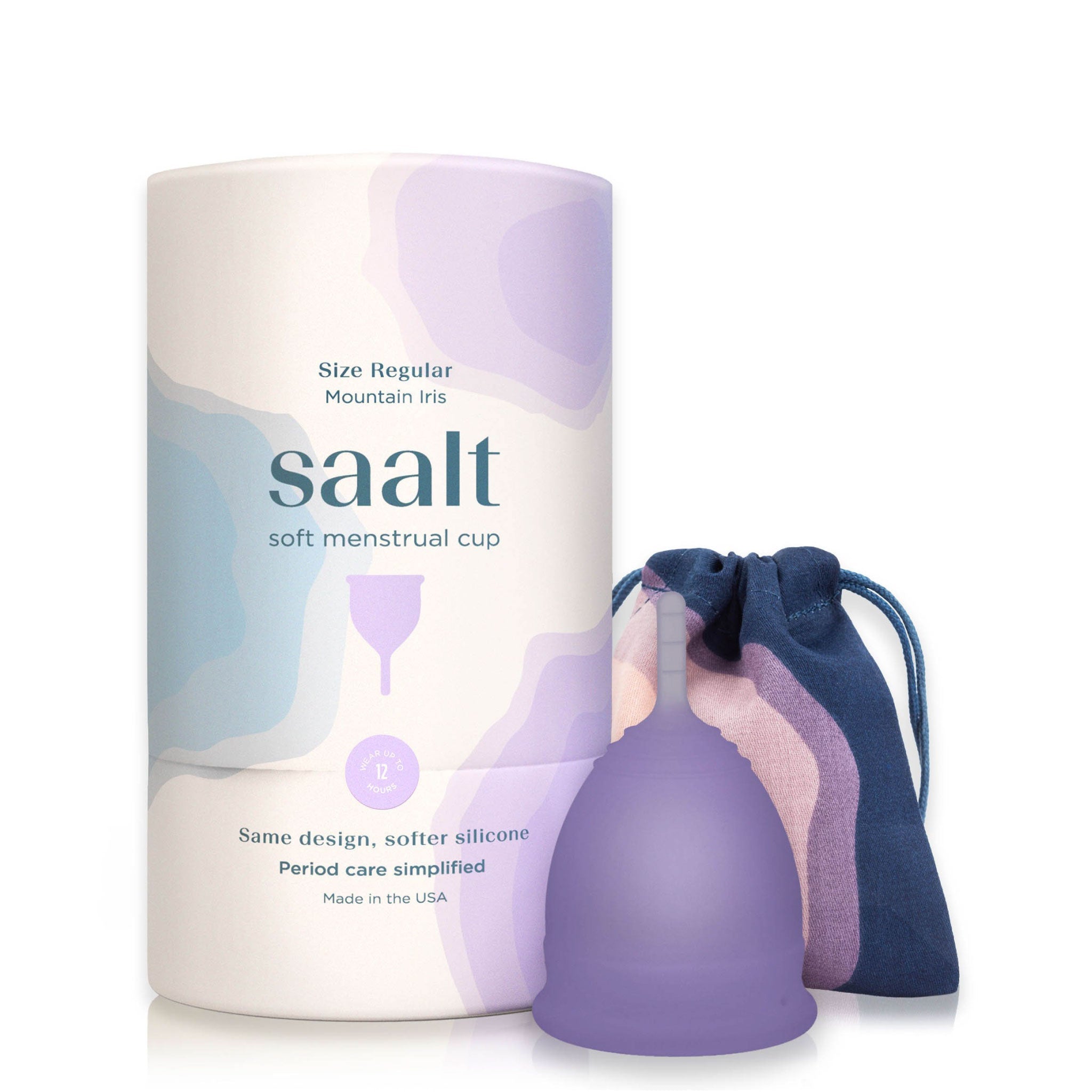Key Takeaways:
- Real Benefits for Real Bodies: Reusable cups reduce long-term waste and irritation, offering a more sustainable and body-aware alternative to tampons and pads—ideal for daily movement, sleep, and sensitive skin.
- How Menstrual Cups Work: Menstrual cups sit inside the vaginal canal and collect fluid, forming a light seal that helps prevent leaks for up to 12 hours. This internal placement reduces dryness and supports your natural pH balance.
- Finding the Right Cup for You: Factors like cervical height, flow level, and pelvic floor strength can help guide your choice. Cups vary in size, shape, and firmness to work with your anatomy and lifestyle at any stage.
The questions around period care are changing, and so are the answers. For decades, disposables reigned as the “normal” solution: a monthly cycle of pads, tampons, wrappers, and waste. Yet, for people who menstruate, “normal” hasn’t always meant comfortable, sustainable, or accessible. In the search for something better, menstrual cups have emerged as a practical, body-friendly alternative, inviting us to reimagine what period care can feel like.
If you’ve ever wondered, “What does a menstrual cup do?” or whether a cup could fit your routine, you’re not the only one. This guide is for anyone exploring reusable period care, whether you’re swapping in for sustainability, seeking leak protection, or just want to feel good about your period decisions. Let’s break down the basics, address the questions, and clear the path toward a new period experience for you and Mother Earth.
Real Benefits for Real Bodies: Why Menstrual Cups Work
Switching to a menstrual cup can reshape how you manage your cycle. From long wear time to sustainable design, each feature is made to meet real-life needs, without compromising comfort or your values.
Wear-All-Day Comfort That Doesn’t Disrupt Your Flow
Menstrual cups sit inside the vaginal canal and collect fluid instead of absorbing it. That difference matters. Fewer people report dryness or irritation compared to tampons, and many feel more at ease during heavier days or overnight. A cup can stay in place for up to 12 hours, offering consistent protection during long shifts, workouts, or travel days without constant changes.
A Smaller Waste Stream Starts with One Reusable Cup
Disposables create lasting waste for something used only once. A menstrual cup, on the other hand, can last years. That means thousands of tampons and pads stay out of landfills—and you reduce plastic use with every cycle. For anyone trying to align daily routines with long-term sustainability goals, this is one small swap with lasting results.
Leak Protection That Works with Your Life
High-capacity menstrual cups hold several times more fluid than a super tampon. They help reduce how often you need to empty or change, which makes a difference when managing heavy flow, traveling, or sleeping through the night. Flexible stems and soft rims adapt to your body for a more secure fit during movement, rest, and everything in between.
Real Insight into Your Body and Your Cycle
Many people say that using a menstrual cup helped them better understand their anatomy and monthly patterns. That insight becomes useful when managing shifting cycles, perimenopause, or conditions like endometriosis, and helps answer what a menstrual cup does beyond basic leak protection. Reusable options like cups offer more flexibility to adapt to those changes, so your care feels like it’s made for your current stage, not a one-size-fits-all routine.

How Does a Menstrual Cup Work?
Menstrual cups offer a straightforward, science-backed approach to period care. People often ask how do diva cups work, but most menstrual cups follow the same principles. Shaped like a bell and made from medical-grade silicone, they’re designed to be both flexible and comfortable. For anyone wondering how does a period cup work on a daily cycle, here’s your answer:
- Folds easily for insertion: Menstrual cups are soft and flexible. When folded and inserted into the vaginal canal, the cup gently unfolds and adjusts to your shape without causing pressure or discomfort.
- Forms a secure seal inside the body: Once inside, the cup creates a light seal against the vaginal walls using your natural anatomy. This seal helps prevent leaks and keeps the cup in place, whether moving, sleeping, or resting.
- Collects fluid rather than absorbing it: Unlike tampons, which can cause dryness, menstrual cups hold your flow in a reservoir. That means less disruption to your natural vaginal moisture and pH balance throughout the day.
- Holds more than a tampon: Most cups can be worn for up to 12 hours and hold several times more fluid than a super tampon, depending on your flow. That’s helpful for long days, overnight wear, or times when restroom access is limited.
- Removes cleanly and rinses easily: To empty the cup, gently pinch the base, remove it, pour out the contents, and rinse with water. After that, the cup is ready to be reinserted. This process becomes easier with practice and typically takes less time than expected.
- Lasts for years with proper care: With regular cleaning and correct storage, a well-made menstrual cup can be reused for up to 10 years, cutting down on landfill waste and constant resupply trips.
- Works for light spotting or heavier flow days: Menstrual cups accomodate your cycle’s natural rhythm and work well as a standalone solution or alongside period underwear for added support. To see which menstrual cup might fit your cycle and comfort level, explore our full collection.
Caring for and Cleaning Your Menstrual Cup
Regular cleaning helps your menstrual cup stay safe, comfortable, and long-lasting. A few small habits make a big difference in how your cup performs over time.
- Rinse right after removal: After taking your cup out, rinse it with cold water first. This step helps prevent staining. Then wash it with warm water and a gentle, fragrance-free cleanser to remove any remaining fluid.
- Use mild, non-irritating soaps: Stick with unscented soap or a cup-specific wash. Harsh chemicals, oils, or strong fragrances can weaken the silicone and irritate sensitive skin.
- Stay clean while out and about: On days when you don’t have access to a sink, wipe the cup with a clean wet paper towel or Saalt Wipes. These alcohol-free, pH-balanced wipes are made for cup care and fit easily into a bag or pocket.
- Deep clean at the end of your cycle: Between periods, boil your cup in water for 4 to 5 minutes to remove any lingering residue. Make sure it doesn’t touch the bottom of the pot by using a whisk or slotted spoon to suspend it gently. Or use a steamer to sanitize your cup.
- Store it in breathable fabric: Once clean and dry, place the cup in a cotton storage pouch, never a sealed or airtight container. Good airflow helps keep bacteria from building up between uses.
- Clean consistently to extend its lifespan: With regular care, your menstrual cup can last for years. That means less waste, fewer repurchases, and more comfort during every cycle.

How to Choose the Right Menstrual Cup for You
Menstrual cups typically come in multiple sizes based on factors like age, childbirth history, and cervical height. Every body is different, and what works for someone else may not be the right fit for you. Here’s what to keep in mind:
- Cervical height: Check during your period by gently inserting a clean finger into your vagina. If your cervix feels high and out of reach, a longer cup is often easier to place and remove. If you can touch it easily, a shorter cup may feel more comfortable and stay better aligned.
- Flow level: A heavier flow might benefit from a higher-capacity cup to reduce how often you empty it throughout the day. For lighter days, a smaller size may be more comfortable.
-
Life stage and body changes: Younger menstruators or people who haven’t given birth often prefer a smaller cup. Postpartum users may need a larger design that accommodates shifts in pelvic anatomy. People experiencing hormonal changes, such as perimenopause, may find comfort in a smaller, softer cup that feels more adaptable.
Firmness and Flexibility: Match Material to Your Body
The firmness of your cup affects how it opens and settles into place once inserted. Firmer cups tend to pop open more easily and stay secure during movement, which can be helpful for people with strong pelvic floor muscles or physically active, like dancers, runners, or folks who regularly practice yoga or Pilates. A softer cup may feel gentler for those with pelvic sensitivity, cramping, or discomfort during insertion.
Stem Design and Length: Tailor to Your Comfort
The stem helps you locate the cup for removal, but it shouldn’t poke or cause irritation. Some people with a low cervix might prefer to trim the stem for a more custom fit. A longer cup with an intact stem may feel more accessible for those with a high cervix. Some cups also come with rounded bases or textured grips, which make removal and positioning easier without needing to rely on the stem alone. Over time, you’ll figure out which details add comfort based on how your body feels throughout your cycle.
Material: Choose Something Safe for Repeated Use
Look for cups made from 100% medical-grade silicone or TPE (thermoplastic elastomer). These materials are soft, long-lasting, and body-safe when cleaned properly. They don’t contain latex, harmful dyes, or fragrances, making them a reliable option for anyone with sensitivities, allergies, or a history of irritation from disposables.
Personal Lifestyle: Think About Daily Use
The best menstrual cup fits how you move through the day. People who travel often, work long shifts, or need overnight protection may prefer a higher-capacity cup that can stay in longer without frequent emptying. Athletes and active users usually feel more secure with a firmer cup and moisture-wicking underwear to stay comfy and dry throughout the day.
Those who want a more minimal experience might lean toward a lower-profile or softer cup. People experiencing cycle changes due to perimenopause, postpartum recovery (after clearance from a healthcare provider), or other hormonal shifts may find that comfort preferences evolve over time—and it’s okay to reassess your fit as your body changes. For a closer look at menstrual cups that match your flow, cervix height, or lifestyle, visit our full range of options.

Final Thoughts
Choosing the right period care shouldn’t feel confusing or out of reach. Menstrual cups represent a real step forward in prioritizing both our comfort and the health of our planet. We designed our cups from the ground up–no outsourced molds, no shortcuts—so that you can count on consistent performance, support, and reassurance, cycle after cycle.
At Saalt, every time we choose a reusable solution, we minimize landfill waste and create a more accessible future for period care. And because we believe in complete transparency, you can always learn more about our patented technology here. No matter where you are on your period journey, we’re here to help you reclaim your cycle, one sustainable choice at a time. For a step-by-step guide to using a disc, check out our how to insert menstrual disc resource.
Read more
- How is a Menstrual Disc Different Than a Tampon?
- Are Reusable Menstrual Products FSA/HSA Eligible?
- The Path to Menstrual Freedom: How Saalt Is Answering the Call
Frequently Asked Questions About Menstrual Cups
How long can you wear a menstrual cup?
Most menstrual cups, including ours, are designed for up to 12 hours of wear at a time. This gives you long, uninterrupted protection without frequent trips to the restroom. That said, your unique flow may require emptying your cup more often, especially on heavier days. Always listen to your body and empty the cup as needed for your comfort and peace of mind.
How do you clean and care for a menstrual cup?
Cleaning your menstrual cup is simple. Rinse it with cool water first, as this helps prevent staining. Then wash with mild, fragrance-free soap and water. Make sure to clean the air holes near the rim as well. Between cycles, we recommend sanitizing your cup in boiling water for 4–5 minutes. Store your cup in a breathable pouch between periods to keep it fresh and ready for next time.
How do you insert a menstrual disc?
A menstrual disc sits higher in the vaginal canal than a cup and tucks behind the pubic bone. To insert it, fold the disc lengthwise, then slide it back and upward until the front rim rests behind your pubic bone. The disc opens naturally and stays in place using your anatomy, no suction or seal required. For step-by-step visuals and tips, visit our how to insert period disc guide.
Can you use a menstrual cup with an IUD?
Yes, many people successfully use menstrual cups with an IUD. It’s important to be gentle during insertion and removal to avoid disturbing the IUD strings. If you’re new to using both together, talk to your healthcare provider for guidance on best practices and to ensure your IUD strings are properly trimmed.
Can menstrual cups cause toxic shock syndrome (TSS)?
Toxic shock syndrome (TSS) is extremely rare with menstrual cup use. Peer-reviewed sources report that, with proper hygiene, the risk is very low. Avoid leaving your cup in for longer than 12 hours, wash your hands thoroughly before handling, and always follow cleaning instructions to minimize risk.
Do menstrual cups affect vaginal pH or flora?
When used correctly, menstrual cups do not appear to disrupt healthy vaginal flora or significantly alter vaginal pH. A review published in The Lancet Public Health found no increased risk of infection or imbalance compared to other period products. Cups made from medical-grade silicone are free from added fragrances, or harmful dyes or additives, which helps maintain your body’s natural environment.
Can you wear a menstrual cup during physical activities or swimming?
Yes, menstrual cups are designed to move with you. Whether you’re running, practicing yoga, swimming, or just going about your day, a menstrual cup stays securely in place and provides leakproof protection. You can swim, sleep, and exercise confidently—period care made simple, no matter your activity.
Sources:
- Van Eijk, A. M., Zulaika, G., Lenchner, M., Mason, L., Sivakami, M., Nyothach, E., ... & Phillips-Howard, P. A. (2019). Menstrual cup use, leakage, acceptability, safety, and availability: a systematic review and meta-analysis. The lancet public health, 4(8), e376-e393.







